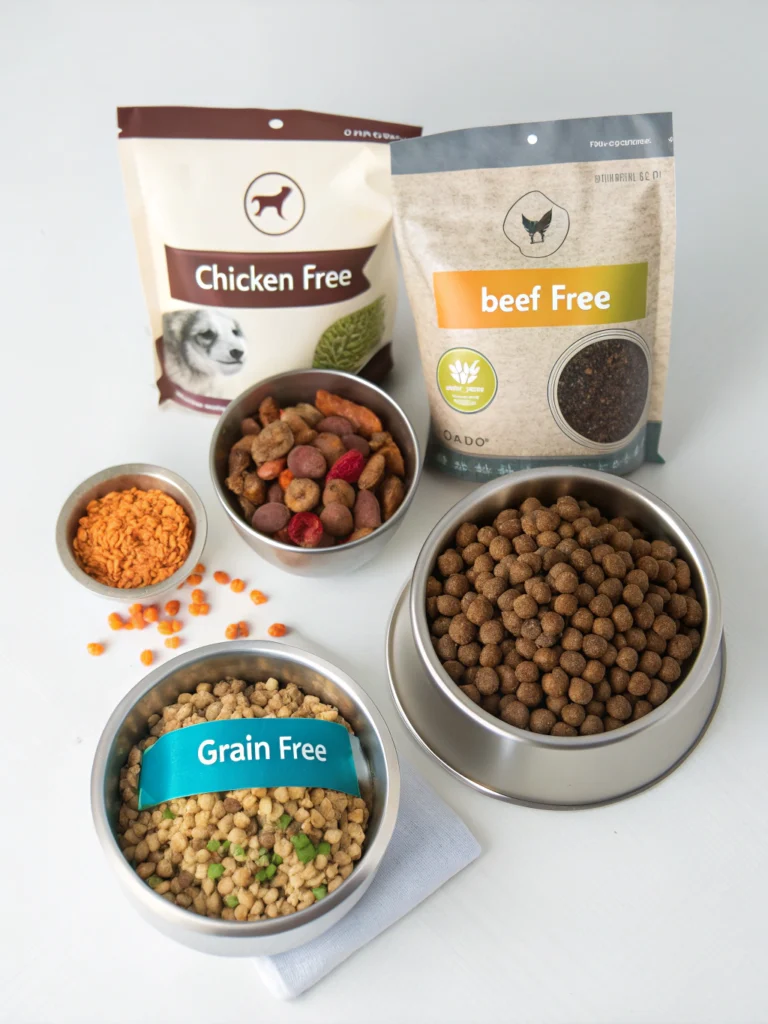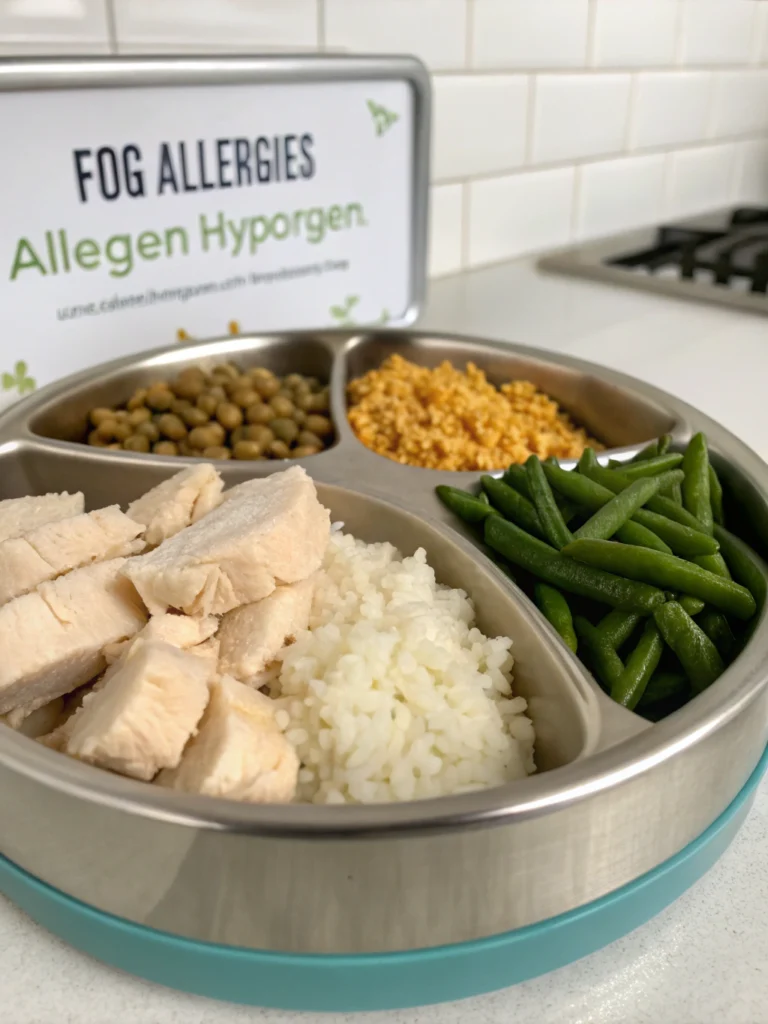Table of Contents
Best Dog Foods for Allergies: Have you ever gazed at your beloved friend and thought, “Could a food intolerance be causing my dog’s constant scratching?” Data indicates that a major percentage of dogs suffer from allergies, which affects their quality of life and comfort. Just like us, dogs can react negatively to some foods we give them, which can range from annoying skin rashes to major intestinal problems.
One of the most common ways to address food allergies or sensitivities in dogs is by transitioning them to specialized diets. Finding the right formulation is key to alleviating symptoms and getting your pup back to their playful best. If you’re facing these challenges, you’re likely searching for reliable guides, such as understanding the nuances between regular and dog allergy food options available today.
This book is totally meant to assist you negotiate the hypoallergenic diet realm. Understanding what is causing your dog’s discomfort—whether it be a response to typical proteins, grains, or synthetic additives—and then choosing the appropriate diet to control it is absolutely first priority. Aiming to identify the ideal food plan for your cherished pet, we will cover top-rated brands and particular formulas recognized for its mild components all through this article. Let’s get in and discover the ideal allergy-friendly food to maintain your dog companion healthy and flourishing!
Understanding Dog Allergies & Sensitivities: Best Dog Foods for Allergies
It’s first important to understand why some dogs respond negatively to what is in their bowl before we go into the details of meals. Usually, dog allergies are an overreaction of their immune system to particular allergens. Although environmental triggers like pollen are frequent, our emphasis here is on hypoallergenic dog food choices meant for diet-related sensitivities or allergies.
The most frequent culprits contributing to food allergies or intolerances in dogs include:
- Protein Sources: Common proteins like beef, chicken, dairy, and wheat gluten are frequent offenders.
- Carbohydrates: Wheat, corn, and soy are also known to cause reactions in sensitive individuals.
- Other Ingredients: Preservatives, artificial colors, or flavor enhancers can sometimes trigger sensitivities.
Often, knowing the underlying reason calls for an elimination diet in which components are methodically eliminated until symptoms improve. This approach can be time-consuming and calls for close tracking; however, buying a well-formulated, allergy-specific diet could be a sensible initial step or supplemental tool after triggers are found.
It is also crucial to differentiate between an allergy and a sensitivity. Usually, true food allergies (driven by IgE antibodies) result in quick, maybe serious responses affecting the skin, respiratory system, or gastrointestinal tract. On the other hand, food intolerances usually just affect the digestive system (e.g., upset stomach) and could not be as severe, yet they greatly affect a dog’s welfare over time.
Top Dog Allergy Food Options in 2025
Especially when your dog’s health is at stake, negotiating the many pet diets on offer could be daunting. Fortunately, 2025 provides a variety of great choices especially created for sensitive dogs. To reduce the likelihood of causing an allergic reaction, these best choices emphasize simple components, unique proteins, and readily digested formulae.
- Novel Protein Diets: These utilize proteins your dog has likely never encountered before, reducing the risk of an allergic reaction. Look for options featuring proteins like duck, venison, salmon, or kangaroo, often paired with simple carbohydrate sources like sweet potato or peas.
- Grain-Free Options: While not exclusively for allergies, removing common grain allergens (wheat, corn, soy) can benefit many sensitive dogs. High-quality grain-free formulas often rely on alternative carbohydrate sources and emphasize real meat.
- Limited Ingredient Diets (LIDs): As the name suggests, these foods contain a minimal number of ingredients, typically focusing on a single novel protein source and one or two easily digestible carbohydrate sources. This makes it easier to pinpoint ingredients your dog tolerates.
- Hydrolyzed Protein Foods: These are considered a gold standard for managing food allergies as they contain proteins broken down into molecules too small for the immune system to recognize as allergens.
- Prescription vs. Over-the-Counter (OTC): Veterinarians often recommend prescription hypoallergenic diets, particularly hydrolyzed options, for moderate to severe allergies. However, excellent OTC limited ingredient and novel protein diets are available that work well for mild to moderate sensitivities.
When evaluating these options, consider your dog’s specific needs, history, and the advice of your veterinarian. Transitioning gradually is also key to success.

Evaluating Your Pup’s Needs
Every dog is different, just like people, and their nutritional requirements can greatly differ. It’s crucial to assess your dog’s particular circumstances before choosing which choice is ideal for your furry buddy.
There are several ways that dog allergies and sensitivities show themselves. Common symptoms are ongoing itching (which causes scratching, gnawing, or licking), redness or inflammation of the skin (particularly around the paws, face, ears, and rear end), chronic ear or skin infections, digestive disturbance such as vomiting or diarrhea, and anal gland problems.
Watch your dog cautiously. When do symptoms become most severe? Do they have more to do with feeding times or environmental changes? Maintaining a symptom diary—recording when flare-ups happen, what your dog consumed, and environmental variables (pollen season, new cleaning products) may be quite useful for your veterinarian.
It’s highly recommended to consult with a veterinarian before making any significant dietary changes for a dog experiencing potential allergy symptoms. The vet can help rule out other health conditions, formulate a diagnostic plan (like an elimination diet), and recommend a suitable commercial food based on your dog’s specific needs. Treatments ranging from strict hygiene routines to special diets (for example, for dog allergy food options) might be tried. While your vet can make strong recommendations, being an informed pet guardian means understanding your options.
Investing time in understanding your dog’s underlying issues – whether related to the hypoallergenic dog food – rather than lifestyle changes – is the likely culprit – and identifying potential triggers is the cornerstone of effective allergy management through diet.
Ingredients to Avoid (If Your Dog is Allergic)
While we’re focusing on the best ingredients to include for hypoallergenic diets, it’s equally important to know which ingredients might cause trouble for sensitive dogs. Identifying and eliminating these potential allergens is often the first step.
Common allergen ingredients in dog foods include:
- Poultry: Including chicken, turkey, and in some cases, chicken by-products.
- Beef & Dairy: Often significant triggers, especially for food intolerances.
- Wheat, Corn, and Soy: These are common fillers and grains that can be problematic for dogs with sensitivities.
- Artificial Additives: Including dyes, preservatives (like BHA/BHT in some lower-quality foods, though many brands avoid these now), and flavor enhancers.
Keep a keen eye on the ingredient list. If your dog has been diagnosed with an allergy to a specific ingredient (say, chicken), look for foods that explicitly state they are “chicken-free” or utilize novel protein sources like duck or venison. Similarly, if grains are the suspected trigger, exploring high-quality grain-free options that replace grains with digestible starches like sweet potatoes or lentils can be beneficial. Remember, what’s an allergen for one dog might be perfectly fine for another. This approach is vital when considering dog allergy food options.
Choosing the Right Type of Food
Once you’ve identified the potential allergens to avoid, the next step is selecting the most appropriate food type for your dog’s needs. This decision often hinges on the severity and type of allergy your dog experienced.
Novel Protein Diets
Novel protein diets utilize a protein source that your dog has likely never eaten before. The idea is that since the immune system hasn’t encountered this protein, it’s less likely to react allergically to it. Excellent hypoallergenic dog food finds frequently include proteins like:
- Duck
- Salmon
- Venison
- Trout
- Rabbit
These foods are often formulated as grain-free or limited ingredient diets, further reducing potential allergens. For instance, a diet might use salmon exclusively as the protein source and sweet potato as the carbohydrate, minimizing the ingredient list.
Grain-Free Diets
Grain-free diets remove common grains like wheat, corn, and soy, which are frequent culprits behind food sensitivities or allergies. Instead, these foods use alternative carbohydrate sources like potatoes, sweet potatoes, peas, or lentils.
- Check Labels: Ensure the food is truly grain-free if that’s the goal, as some products might substitute problematic grains with other allergenic ingredients.
- Not Just for Allergies: Grain-free diets can sometimes be marketed as healthier, but they are primarily designed for dogs with grain-related sensitivities.
- Consult Your Vet: Before opting for a grain-free diet, especially if your pet has not been diagnosed with a specific grain allergy, it’s wise to consult your veterinarian.
Limited Ingredient Diets (LIDs)
Limited Ingredient Diets (LIDs) are a cornerstone of managing canine food allergies and sensitivities. The premise is simple yet effective: use the fewest ingredients possible that still provide complete and balanced nutrition.
- Key Features: LID foods typically feature one novel protein source (e.g., bison instead of chicken) and one or two highly digestible carbohydrate sources (e.g., pumpkin and tapioca).
- Benefit: By minimizing potential allergens, LIDs make it easier to identify food intolerances and reduce the likelihood of an adverse reaction.
- Excellent Choice: For dogs experiencing chronic skin irritation or digestive upset, an LID formula recommended by your vet is often a highly effective solution.
Switching to Allergy-Free Formula: A Gradual Transition Plan
Okay, you’ve identified potential allergens with your vet’s help and found a promising hypoallergenic food option. The next crucial step is transitioning your dog to the new diet. Doing this too quickly can lead to digestive upset, negating the benefits of the allergen-free formula. Here’s a recommended gradual transition plan:
- Preparation: Measure out the quantities for the next few days to simplify the process. Knowing the precise amounts helps maintain consistency.
- Week 1: Start by mixing 75% of your dog’s current food with 25% of the new allergen-free food.
- Week 2: Adjust the ratio to 50% of the old food and 50% of the new food. Observe your dog’s reaction to this blend.
- Week 3: Shift the ratio to 25% of the old food and 75% of the new food. This continues acclimating their digestive system.
- Week 4: Hopefully, you are now fully transitioned to 100% of the new allergen-free food!
This 3-4 week transition period typically allows your dog’s gut flora to adjust to the new ingredients. Stick to consistency, and perishable items need careful time management.
Introducing the Top 5 Hypoallergenic Dog Foods for 2025
Now, let’s get down to the specifics. Based on research, veterinarian recommendations, and positive owner feedback, here are some top contenders in the hypoallergenic dog food market for 2025:
- Purina Pro Plan Veterinarian Diet HA Hydrolyzed Formula:
- Why it’s great: Utilizes highly purified hydrolyzed protein sources (so small they don’t trigger allergies) and easily digestible carbohydrate sources. It’s often vet-recommended for confirmed food allergies.
- Ideal For: Dogs with confirmed food allergies, moderate to severe sensitivities.
- Zignature Limited Ingredient Formula – Salmon & Cranberry:
- Why it’s great: Features high-quality salmon and sweet potatoes as primary ingredients. The formula is limited to reduce potential allergens.
- Ideal For: Pups whose allergies/irritable bowel syndrome(U) point to a limited ingredient with a novel protein source like salmon and are allergic to chicken.
- Royal Canin Hypoallergenic (HK) Dry Dog Food:
- Why it’s great: Contains hydrolyzed soy protein (shares a similar profile with hydrolyzed chicken soy can be heavily allergy-causing in highly specific dog individuals). Incorporating this into food for pets, especially for those with a grain allergy or intolerance, is a key concept. Formulated with psyllium and beet pulp to promote digestive health. Often backed by veterinary endorsement.
- Ideal For: Dogs with moderate to severe food allergies and sensitivities, often recommended by veterinarians.
- Merrick Backcountry Raw Infused Limited Ingredient Trout Recipe:
- Why it’s great: Offers a novel protein source (trout) alongside easily digestible carbohydrates like potatoes. Contains “rawfections” – pieces of dehydrated raw trout for enhanced palatability.
- Ideal For: Dogs preferring a novel protein source, who might struggle with digestion, and enjoy a bit of raw.
- Orijen Six Fish Grain-Free Dry Dog Food:
- Why it’s great: Features multiple types of fish (a novel protein if your dog is used to chicken or beef), making it highly palatable. Rich in animal protein and omega fatty acids for skin and coat health.
- Ideal For: Highly active dogs needing high protein or those needing grain自由 options due to other health concerns and sensitivity to certain proteins.
While these are top-rated options, it’s crucial to remember that results can vary. Always work with your vet to diagnose and manage food allergies. These options represent a great starting point if you need to find dog allergy food options.
Nutritional Needs of Sensitive Dogs
Even when managing allergies, your dog still requires a complete and balanced diet. It’s not just about eliminating allergens; it’s also about providing adequate nutrition to support their overall health.
Factors to keep in mind:
- Balanced Macronutrients: Ensure the food has appropriate levels of protein, fat, and carbohydrates, even when using novel ingredients.
- Essential Fatty Acids: Ingredients like salmon often provide Omega-3 fatty acids, known for their anti-inflammatory properties, which can benefit dogs with skin conditions.
- Quality Protein Sources: Whether novel like duck or venison, or hydrolyzed, the protein source should be high-quality and easily digestible.
- Digestive Enzymes & Prebiotics: Some hypoallergenic foods include added fiber like pumpkin or prebiotics to support digestive health.
When selecting a food for your sensitive dog, check the guaranteed analysis and nutritional adequacy statement (AAFCO statement) to ensure it meets their requirements for life stage and activity level. Your vet can offer specific recommendations based on these factors.
Managing Costs and Accessibility
Investing in specialized hypoallergenic dog food can sometimes feel daunting due to the perception of higher costs. However, the potential health benefits and reduced vet visits due to managing allergies effectively can offset the budget. Fortunately, 2025 sees a wider availability of various options at different price points.
- Veterinarian Recommended Brands: These are often high-quality but can command a higher price, especially prescription diets.
- Over-the-Counter (OTC) Options: Many excellent LID and novel protein diets are available without a prescription from pet specialty stores and reputable online retailers. Comparing prices from different vendors can often yield savings.
- Subscription Services: Platforms like NomNomNow (which requires a prescription though usually offers a sampler/trial to introduce your dog to it) or JustFoodForDogs offer customized, fresh meals, often made with novel proteins, though usually these approaches cost more than commercially produced foods. Subscription models can sometimes offer discounts on per-bag costs over time.
Consider your dog’s daily food intake and work out an average cost. Sometimes, a smaller bag of a higher-quality limited ingredient diet might be more cost-effective than a large bag of a less specialized kibble, especially if it resolves medical issues and improves their quality of life. Markups can vary widely across the industry. If you suspect your furry friend has food allergies, try selecting foods designed for sensitive dog’s needs
Key Components Of An Allergy-Friendly Diet
Finding these essential ingredients on the package of various food items might significantly affect your dog’s health. Managing your dog’s allergies well usually means paying attention to particular food traits. Emphasizing these fundamental elements can help you to build a more favorable internal environment for the immune system. Although controlling allergies with diet is not easy, knowing these vital components on the label of hypoallergenic food choices makes it a less difficult process.
So, what should you look for?
- Single, Novel Protein Source: This is the cornerstone. Choose a food featuring a protein your dog has never or rarely eaten, minimizing the chance of an allergic reaction. Common examples include duck, venison, rabbit, fish, or even novel proteins like kangaroo or bison. Examples include finding xxx for a xxx diet.
- Minimal Ingredient Count: Fewer ingredients mean fewer potential allergens. Limited Ingredient Diets (LIDs) focus on providing what the dog needs without unnecessary extras. Finding novel proteins, such as green veal or kangaroo, in hypoallergenic dog food helps address the root cause. The fewer ingredients in a diet, the fewer potential triggers.
- High-Quality, Digestible Carbohydrate(s) Thankfully, some grain-free kibble formulas feature novel proteins, making them ideal choices for dogs with food sensitivities. Examples include sweet potato, brown rice, tapioca, or peas.
- Hydrolyzed Protein Option (If Needed): For severe or difficult-to-control allergies, especially those requiring a prescription, hydrolyzed proteins (broken down into amino acids too small for the immune system to recognize) are often the best way to address the situation directly, typically available via a veterinarian.
When comparing brands, always read the ingredient list thoroughly.
Conclusion: Finding Food Harmony for Your Sensitive Pup
Owning a pet is surely made more difficult by caring for a dog with dietary allergies or sensitivitivities. Your dog’s general quality of life will be much improved and pain will be reduced by knowing the vital ideas such as removing certain protein or general allergy triggers and selecting the appropriate food, including a restricted ingredient diet with novel protein sources like duck.
With 2025 offering many excellent dog allergy food options, coupled with increasing choices for hypoallergenic dog food , you have numerous tools at your disposal. Remember that collaborating closely with your veterinarian is paramount to correctly diagnose allergies, understand the subtle differences between standard and recommended dog food for allergies, and tailor a dietary strategy that works best for your furry companion. Patience, observation, and professional guidance are your keys to success in managing your dog’s dietary needs and keeping them happy and healthy.



